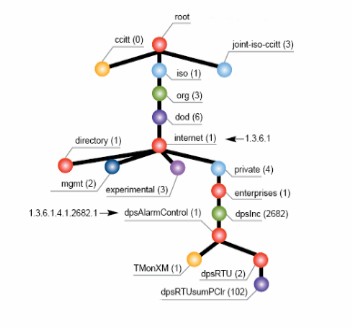The Simple Network Management Protocol (SNMP) is an application layer protocol (according to RFC 1157) that facilitates the exchange of management information between network devices. It is a part of the Transmission Control Protocol/Internet Protocol (TCP/IP) protocol suite. SNMP enables network administrators to manage network performance, find and solve network problems, and plan for network growth.
An SNMP-managed network consists of three key components: managed devices, agents, and network-management systems.
| · | A managed device is a network node that contains an SNMP agent and that resides on a managed network. Managed devices collect and store management information and make this information available to network-management system using SNMP. Managed devices, sometimes called network elements, can be routers and access servers, switches and bridges, hubs, computer hosts, or printers.
|
| · | An agent is a network-management software module that resides in a managed device. An agent has local knowledge of management information and translates that information into a form compatible with SNMP.
|
| · | An network-management system (NMS) executes applications that monitor and control managed devices. an network-management system provides the bulk of the processing and memory resources required for network management. One or more network-management systems must exist on any managed network.
|
SNMP Basic commands
Managed devices are monitored and controlled using three basic SNMP commands: read, write, and trap.
| · | The read command (GET) is used by an NMS to monitor managed devices. The NMS examines different variables that are maintained by managed devices.
|
| · | The write (SET) command is used by an NMS to control managed devices. The NMS changes the values of variables stored within managed devices.
|
| · | The trap command is used by managed devices to asynchronously report events to the NMS. When certain types of events occur, a managed device sends a trap to the NMS.
|
SNMP Management Information Base
A Management Information Base (MIB) is a collection of information that is organized hierarchically. MIBs are accessed using a network-management protocol such as SNMP. They are comprised of managed objects and are identified by object identifiers.
A managed object (sometimes called a MIB object, an object, or a MIB) is one of any number of specific characteristics of a managed device. Managed objects are comprised of one or more object instances, which are essentially variables.
Two types of managed objects exist: scalar and tabular. Scalar objects define a single object instance. Tabular objects define multiple related object instances that are grouped in MIB tables.
An example of a managed object is atInput, which is a scalar object that contains a single object instance, the integer value that indicates the total number of input AppleTalk packets on a router interface.
An object identifier (or object ID) uniquely identifies a managed object in the MIB hierarchy. The MIB hierarchy can be depicted as a tree with a nameless root, the levels of which are assigned by different organizations.
The top-level MIB object IDs belong to different standards organizations, while lower-level object IDs are allocated by associated organizations.

|
Vendors can define private branches that include managed objects for their own products. MIBs that have not been standardized typically are positioned in the experimental branch.
The managed object atInput can be uniquely identified either by the object name—iso.identified-organization.dod.internet.private.enterprise.cisco.temporary variables.AppleTalk.atInput—or by the equivalent object descriptor, 1.3.6.1.4.1.9.3.3.1.
Send feedback on this topic.
Copyright © 2004-2013, SAE - Automation, s.r.o. (Ltd.), All rights reserved.